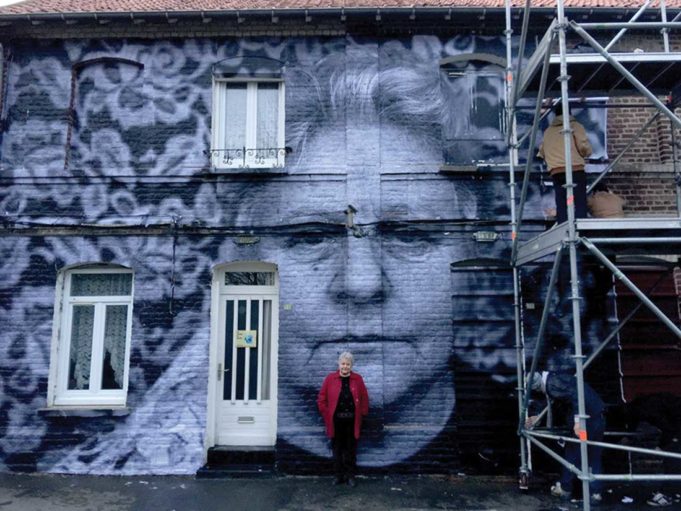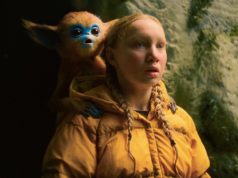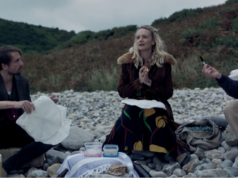The types of documentaries that tend to win awards and appear on lists like this one are films that tackle Big Issues: wars, the environment, great men, the ongoing fight against social injustice. In 2017, I found an unusual number of really good films that addressed other subjects that aren’t as sexy but are no less important. Sometimes terrific stories are found in places where no one else is looking, or in a filmmaker’s imagination that ties together themes that seem unconnected.
By the way, if you’re wondering where I Am Not Your Negro is, it made my honorable mention list last year. If I’d counted Raoul Peck’s biography as one of this year’s films, it would place at No. 9 here.
1.) Faces Places. The movie’s French title Visages, villages translates to “Faces, Villages,” but the distributors who translated the title into English were right to keep the rhyme. The lioness of the French New Wave, Agnès Varda went on a road trip with the artist who goes by the name of JR, visiting small, hardscrabble villages in rural France and pasting large-scale photographs of people’s faces on the sides of their houses and workplaces. It’s gratifying to see these country folks light up at seeing themselves memorialized so, but it’s even better to see the friendship between the 89-year-old Varda and the 34-year-old JR give so much life to both of them.
2.) Icarus. Bryan Fogel stumbled onto this story. An amateur cyclist from Colorado, he planned to cheat in an amateur race, document his cheating, and beat the race’s doping tests to prove that testing was a charade. Instead, he watched his expert advisor, Russian lab director Grigory Rodchenkov, become a key figure in the World Anti-Doping Agency’s sweeping investigation into massive state-sponsored doping that wound up getting the Russian federation banned from the upcoming Winter Olympics. It plays out like a John le Carré spy thriller, except that le Carré never invented a character like Rodchenkov, who’s as shady as a $3 bill but whose filthy sense of humor makes him a delight to be around and who does the right thing in the end and pays for it.
3.) Whose Streets? If you want a visceral documentary that will make you raise your fist and go marching in protest, you can’t do better than Sabaan Folayan and Damon Davis’ you-are-there account of the formation of Black Lives Matter in Ferguson, Mo. Taking the point of the grassroots activists who found America’s latest racial flashpoint happening in their hometown, the film makes extensive use of cellphone footage and tweets to show how the mourning for Michael Brown turned into the first social awareness movement, online and in real time. Too many white people trust the word of other white people (including the mainstream media) for what Black Lives Matter means. This movie, burning with righteous anger, is straight from the people who lived through Ferguson’s injustice and turned it into action.
4.) I Called Him Morgan. If you don’t know the story of Lee Morgan, Kasper Collin’s biography may look like that old cliché, the story of a visionary jazz musician who got hooked on heroin. However, even if you do know his story, you’ll be surprised at the twists and turns that this takes as it turns into a gripping true crime saga whose participants are motivated by all-too-human flaws. Colleagues of Morgan, such as Wayne Shorter and Bennie Maupin, provide vivid reminiscences of the trumpeter and the man, but almost as compelling as the story itself is the one about how a former radio DJ and adult education teacher named Larry Reni Thomas got the story from Helen Morgan — the woman who loved Lee, saved his life, and then murdered him — just before she died.
5.) Dawson City: Frozen Time. More than 500 Hollywood silent films were believed to be lost forever until copies of them turned up in the 1970s, preserved beneath the permafrost of the former provincial capital of Yukon. The story of how they got there turns out to be intertwined with the history of this former mining boomtown that attracted all manner of enterprising folks, chancers, and current and future celebrities and business moguls. It also involves quite a bit of hockey, since this is a Canadian story. Bill Morrison puts it all together in dreamlike fashion, turning this into a meditation on the passage of time and the fragility of human aspirations (and nitrate film stock).
6.) Rat Film. “The adult Norway rat is capable of jumping to a height of 32 inches,” this film informs us as we see a rat trying to jump out of a garbage can. “Baltimore city trash cans are 34 inches tall.” So begins Theo Anthony’s disquieting essay, which starts out discussing Baltimore’s pest-control measures but effortlessly segues into the history of rats as lab test animals, a sidebar on reptile keepers who raise rats as food for snakes, and how the city’s long-ago push for legalized segregation led to the social injustices of the present day. In a scant 82 minutes, this dry and scientific film covers a lot of ground and will rile you up as you see how Baltimore treated its African-American population scarcely better than vermin.
7.) Trophy. This film will be sure to enrage both the animal-rights crowd and the pro-hunting crowd, because neither of them comes out of it in a flattering light. Christina Clusiau and Shaul Schwartz explore the billion-dollar industry of big-game hunting, which transports Americans and Canadians with too much money to Africa to shoot lions, tigers, and elephants. The filmmakers quickly run into an ethical thicket of conservationists, Africans being preyed on by the big cats, dismissive and condescending pro-animal activists, and farmers breeding the animals to maintain their populations for the hunters. What does it say about us that the only reason we keep these majestic animals on the planet is so we can kill them? It can’t be good.
8.) Ex Libris: The New York Public Library. Frederick Wiseman just turned 88 and still keeps turning out these capacious, exhaustive documentaries. Here, he turns his searching gaze to the world’s fourth largest library, and it comes off like a Jorge Luis Borges fever dream, an endless building where there’s something fascinating happening in every room: job recruiters pitch people on becoming firefighters, Elvis Costello discusses his father’s impact on his music, a professor discusses 19th-century critiques of slavery, a worried-looking man looks up cancer treatments. This 197-minute film eventually coheres into a deeply moving portrait of an institution that functions not just as a book repository but as a place to nourish the mind and soul of the city.
9-11.) (tie) City of Ghosts, Last Men in Aleppo, and Human Flow. Three films about the refugee crisis get squeezed into the last two slots here. Matthew Heineman’s City of Ghosts focuses on the journalists trying to report on the enormous damage to Raqqa, Syria, during ISIS’ takeover. Firas Fayyad’s Last Men in Aleppo moves west and follows the White Helmets as they dig people out from under the rubble of various bombings. Ai Weiwei’s Human Flow pulls back to a God’s-eye point of view to show the sheer scale of the global refugee problem. These films vary widely in their techniques, but they all dare you to look at the suffering of these people and turn away. The current White House is too cowardly to help them, but we don’t have to be.
Honorable mention: David France’s The Death and Life of Marsha P. Johnson; Amanda Lipitz’ Step; Lydia Tenaglia’s Jeremiah Tower: The Last Magnificent; Ceyda Torun’s Kedi; Errol Morris’ The B-Side: Elsa Dorfman’s Portrait Photography; Griffin Dunne’s Joan Didion: The Center Will Not Hold; John Scheinfeld’s Chasing Trane: The John Coltrane Documentary.













nice